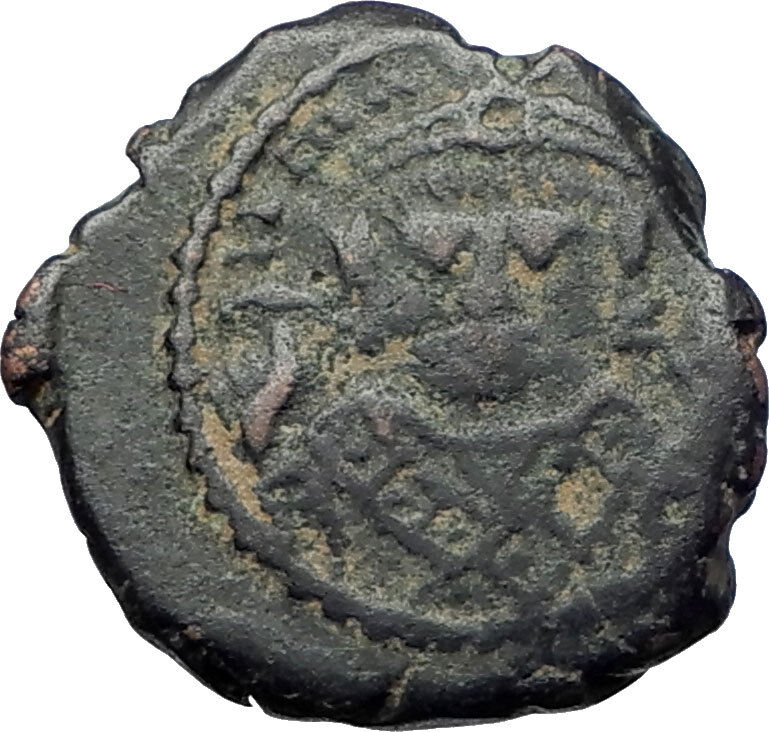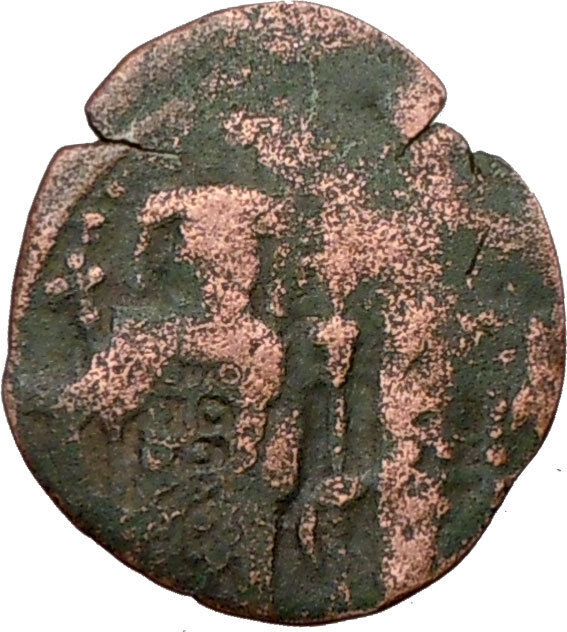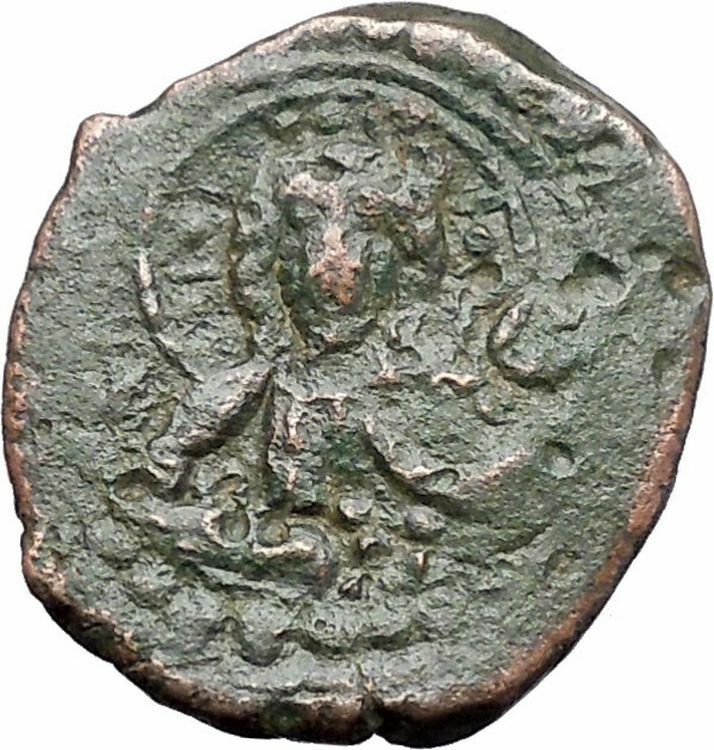|
Byzantine – Anastasius I – April 11, 491 A.D. – July 1, 518
A.D. –
Bronze Nummus 10mm (0.92 grams) Struck circa 491-518 A.D.
Reference: SB 13, DOC I 15, MIB 40
DNANAS – Diademed, draped and cuirassed bust right.
Circle, monogram
 within. within.
You are bidding on the exact item pictured,
provided with a Certificate of Authenticity and Lifetime Guarantee of
Authenticity.

Flavius Anastasius or Anastasius I (c. 430 – July 518)
was
Byzantine Emperor
from 11 April 491 until his death in 518.
In a larger context the Byzantine empire as such could be said to have
started when the ancient city of Byzantium was renamed Constantinople by
Constantine I and made a political axis on a par with Rome. Numismatic
historians, however, classify Anastasius as the last Roman Emperor and the first
Byzantine one. Although he considered himself “Roman”, along with all future
Byzantine emperors, his choice in 498 to discard the then monetary system in
favor of a new, more Greek-aligned one was a lasting landmark of profound
significance. Culturally, the Byzantines were always Greek under their skin and
as the influence of the Romans waned there was ever less reason to reflect what
to them was a foreign culture even at an official level. Within another hundred
years most distinctly Roman traits had been supplanted by the new zeitgeist
which better served, after all, a Greek citizenry.
During his reign he consolidated power in what was left of
the eastern half of the empire and gave up for lost the barbarian-infested
western one. To his credit, he was a shrewd administrator and settled several
favorable trade treaties which started off the Byzantine period on sound
financial footing.
//
Background
and personal characteristics
Anastasius was born at
Dyrrhachium
; the date is unknown, but he is thought to have been born no
later than 430 or 431. He was a son of Pompeius (born c. 410),
Nobleman
of Dyrrachium, and wife Anastasia Constantina (born c. 410).
His mother was an
Arian
,
sister of Clearchus, also an Arian, and a paternal granddaughter of … Gallus
(born c. 370), son of Anastasia (born c. 352) and husband, in turn
daughter of Flavius Claudius
Constantius Gallus
and wife and cousin
Constantina
.
Anastasius had one eye black and one eye blue (heterochromia),
and for that reason he was nicknamed Dicorus (Greek: Δίκορος, “two-pupiled“).
Accession
At the time of the death of
Zeno
(491), Anastasius, a palace official (silentiarius),
held a very high character, and was raised to the throne of the Eastern Roman
Empire by
Ariadne
, Zeno’s widow, who preferred him to Zeno’s brother,
Longinus
.
Ariadne married him shortly after his accession on 20 May 491. His reign,
though afterwards disturbed by foreign and internecine wars and religious
distractions, commenced auspiciously. He gained the popular favour by a
judicious remission of taxation, and displayed great vigour and energy in
administering the affairs of the empire.
Foreign
policy and wars
The principal wars in which Anastasius was engaged were the
Isaurian War
and the
War
with Persia
.
The former, which lasted from 492 to 497, was stirred up by the supporters of
Longinus
, the brother of Zeno who had been candidate to his succession
against Anastasius. The
battle of
Cotyaeum
in 492 “broke the back” of the revolt, but
guerrilla warfare
continued in the
Isaurian
mountains for some years longer.
In the
war
with Sassanid Persia
(502–505),
Theodosiopolis
and
Amida
were captured by the enemy, but the Persian provinces also suffered
severely and the Byzantines recovered Amida. Both adversaries were exhausted
when peace was made (506) on the basis of the status quo. Anastasius
afterwards built the strong fortress of
Daras
to hold in check the Persians in
Nisibis
. The Balkan
provinces however were left denuded of troops and were devastated by
invasions of
Slavs
and Bulgars
; to protect
Constantinople
and its vicinity against them the emperor built the
Anastasian Wall,
extending from the
Propontis
to the
Euxine
.
Domestic
and ecclesiastical policies
The emperor was a convinced
Miaphysite
, following the teachings of
Cyril of
Alexandria
and
Severus of
Antioch
who taught “One Incarnate Nature of Christ” in an undivided union of
the Divine and human natures, but his ecclesiastical policy was moderate; he
endeavoured to maintain the principle of the
Henotikon
of Zeno and the peace of the church. It was rebellious demonstrations of the
Byzantine populace, that drove him in 512 to abandon this policy and adopt
miaphysitic programme. His consequent unpopularity in the European provinces was
utilized by an ambitious man, named
Vitalian
, to organize a dangerous rebellion, in which he was assisted by a
horde of “Huns”
(514-515); it was finally suppressed by a naval victory won by the general
Marinus
.
Successor
The Anonymous Valesianus tells an account about his choosing of a successor:
Anastasius could not decide which of his three nephews should succeed him, so he
put a message under a couch and had his nephews take seats in the room, which
also had two other seats; he believed that the nephew to sit on the special
couch would be his proper heir. However, two of his nephews sat on the same
couch, and the one with the concealed message remained empty. Then, after
putting the matter to God in
prayer
, he
determined that the first person to enter his room the next morning should be
the next emperor, and that person was
Justin
, the
chief of his guards. In fact, Anastasius probably never thought of Justin as a
successor, but the issue was decided for him after his death. At the end of his
reign, he left the imperial treasury richer by 23,000,000 solidi or
320,000 pounds of gold.
Anastasius died childless in Constantinople on 9 July 518 (some sources say 8
or 10 July) and was buried at the
Church of the Holy Apostles
.
Family
Anastasius is known to have had a brother named Flavius Paulus, who served as
Roman consul
in 496. A sister-in-law, known as Magna, was mother to Irene
and mother-in-law to Olybrius. This Olybrius was son of
Anicia Juliana
and
Areobindus Dagalaiphus Areobindus
. The daughter of Olybrius and Irene was
named Proba. She married Probus and was mother to a younger Juliana. This
younger Juliana married another Anastasius and was mother of Areobindus,
Placidia, and a younger Proba. Another nephew of Anastasius was Flavius Probus,
Roman consul in 502. Caesaria, sister of Anastasius, married Secundinus. They
were parents to Hypatius
and Pompeius. Flavius Anastasius Paulus Probus Moschianus Probus
Magnus, Roman Consul in 518 also was a great-nephew of Anastasius. His daughter
Juliana later married
Marcellus
, a brother of
Justin II
.
The extensive family may well have included viable candidates for the throne.
|









